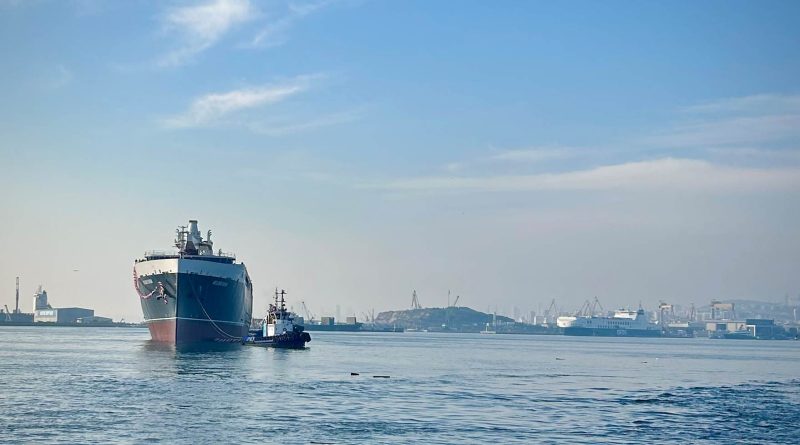Turkey Launches the World’s Longest Wind-Powered Cargo Ship
Turkey has launched the Neoliner Origin, the world’s longest wind-powered cargo ship. At 136 meters in length, this pioneering vessel is designed to cut fuel consumption and carbon emissions, marking a significant breakthrough in maritime transport.
Built by Turkey’s RMK Marine and developed by the French company Neoline, the ship is powered primarily by wind, utilizing 3,000 square meters of sails. With global shipping responsible for nearly 3% of worldwide CO₂ emissions, the Neoliner Origin represents a crucial shift toward low-carbon cargo transport.
A breakthrough in sustainable shipping
Unlike conventional cargo ships that burn vast amounts of fossil fuels, the Neoliner Origin is designed to harness the power of the wind, significantly reducing its environmental impact.
The ship measures 136 meters in length and is equipped with 3,000 square meters of sails. It has a cargo capacity of 5,300 tons and operates primarily on wind power, though it also has auxiliary engines. While traditional cargo ships travel at around 15 knots, the Neoliner Origin operates at 11 knots to optimize fuel efficiency.
The vessel is scheduled for delivery in June 2025, with its first commercial voyage expected in July 2025. It will follow a route that connects ports in France, the United States, and Canada, specifically Saint-Nazaire, Baltimore, Halifax, and Saint-Pierre-et-Miquelon. By reducing its speed and maximizing the use of wind propulsion, the ship is expected to cut fuel consumption by up to 80%, making it one of the most environmentally friendly cargo vessels in operation.
How wind propulsion cuts emissions
The shipping industry is a major contributor to global carbon emissions, producing approximately 940 million tonnes of CO₂ annually. As a result, it faces increasing pressure to comply with new emissions regulations, including the International Maritime Organization’s Carbon Intensity Indicator and the European Union’s Emissions Trading System.
Wind-assisted propulsion offers significant environmental benefits. The Neoliner Origin’s use of sails can reduce fuel consumption by up to 80% compared to traditional cargo ships. By relying primarily on wind power, it significantly lowers greenhouse gas emissions, making it a viable option for companies looking to align with the International Maritime Organization’s 2050 decarbonization goals. Additionally, by reducing its dependency on fossil fuels, the ship helps decrease operating costs, offering both environmental and economic advantages.
Experts believe that wind propulsion, when combined with alternative fuels like hydrogen and ammonia, could play a crucial role in transforming maritime transport and accelerating the industry’s transition to net-zero shipping.
Economic feasibility and industry adoption
Wind-powered cargo ships require higher initial investment than conventional vessels. However, they offer long-term financial savings by reducing fuel expenses. The Neoliner Origin’s hybrid system, which minimizes fossil fuel use, provides a significant economic advantage as fuel prices continue to fluctuate.
Despite its potential, wind-powered shipping faces several challenges. One of the main concerns is transit time, as wind-powered vessels typically move slower than their fuel-powered counterparts. Infrastructure at ports may also need adjustments to accommodate sail-powered ships, adding another layer of logistical complexity. Additionally, the upfront investment for these vessels remains higher than traditional cargo ships, which could slow widespread adoption.
However, major logistics companies such as Renault have already committed to wind-powered shipping solutions, demonstrating confidence in the model. As sustainability regulations tighten and fuel costs remain volatile, wind-powered shipping could become increasingly attractive to the global maritime industry.
The future of wind-assisted cargo transport
The launch of the Neoliner Origin is just the beginning of a larger movement toward wind-powered cargo transport. Several companies are investing in similar fleets, and experts predict that by 2050, up to 40% of cargo ships could integrate wind-assisted propulsion.
With this breakthrough, more shipping companies are expected to explore wind propulsion technology, particularly as regulations continue to push for reduced emissions in maritime transport. Hybrid models that combine wind power with alternative fuels, such as hydrogen or ammonia, are also likely to emerge as part of a broader strategy for sustainable shipping.
As shipping companies seek greener alternatives, wind propulsion is emerging as a practical and scalable solution. With its innovative design and significant emissions reductions, the Neoliner Origin could mark the beginning of a new era in sustainable maritime transport.
Sources:
To keep up-to-date with our latest transportation and logistics news, subscribe to our newsletter today.
